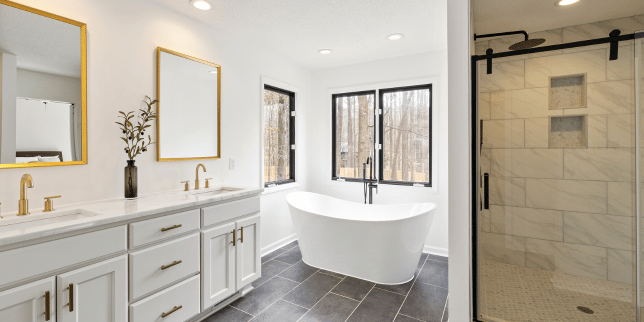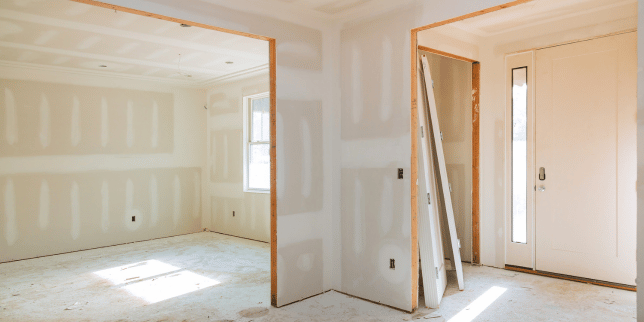How the Color Temperature Scale Can Influence Your Home Remodel
December 13th, 2024
5 min read

Your home is a reflection of your style and needs, but have you ever considered how lighting influences its atmosphere and functionality? Many homeowners overlook the power of the color temperature scale in transforming their living spaces, leading to rooms that feel out of sync with their purpose.
At Custom Built Design & Remodeling, we understand the importance of creating a home that works for your family on every level. With our expertise in home remodeling and design, we guide homeowners in the Greater Lansing area to make informed decisions about lighting, ensuring each room sets the right tone and enhances daily life.
In this article, we’ll show you how to use the color temperature scale to create the perfect mood, improve functionality, and highlight your home’s best features:
- Sets the Right Mood for Each Room
- Improves Room Functionality
- Enhances Paint Colors
- Highlights Architectural Features
- Adjusts with the Natural Light Cycle
- Affects Perception of Space Size
- Promotes Health and Well-Being
1. Sets the Right Mood for Each Room
Lighting goes beyond simple illumination—it plays a pivotal role in shaping the atmosphere of a space. The right color temperature can create a sense of intimacy, relaxation, or energy, depending on its application.
When it comes to selecting the right lighting for your home, the Kelvin Temperature Scale is a key tool. The Kelvin Temperature Scale, measured in degrees Kelvin (K), shows the color of light, from warm yellow tones to cool blue hues.
By understanding the effects of warm and cool lighting, you can tailor each room to fit your lifestyle and emotional needs:
- Warm Light (2000K–3000K): This soft, amber glow evokes a sense of comfort and calm. It is perfect for spaces like living rooms, bedrooms, and dining areas where you want to unwind or connect with loved ones.
- Neutral Lighting (3500K–4500K): Offers a balance between warm and cool tones. This is ideal for spaces requiring both comfort and functionality, such as kitchens and bathrooms.
- Cool Light (5000K–6500K): Cool tones are perfect for task-focused spaces like home offices, workshops, or kitchens.
2. Improves Room Functionality
Strategic lighting isn’t just about aesthetics; it’s also a vital tool for improving how effectively a room serves its purpose. Each room typically benefits from layered lighting options that cater to different activities and moods. This layered lighting strategy ensures every room adapts to your needs, blending functionality with comfort.
Choosing the right fixtures and color temperatures makes every space functional and inviting:
- Kitchens: Use cool white lights (5000K–6500K) for tasks like cooking and food prep, but incorporate warm light options, such as pendant lights or under-cabinet lighting, to create a cozy atmosphere for dining or casual gatherings.
- Living Rooms and Dining Rooms: Opt for warm lighting (2000K–3000K) to set a relaxing tone for entertaining or family time, and consider layering with accent or dimmable lights to adjust the ambiance for various activities.
- Bedrooms: Include dimmable warm-toned lights for winding down at night and neutral tones for daytime tasks like reading, dressing, or working in a multifunctional space.
- Bathrooms: Pair cool white lights around mirrors for makeup or grooming with softer, warmer lighting to evoke a spa-like ambiance for unwinding at the end of the day.
3. Enhances Paint Colors
Lighting has a profound effect on how colors appear in your home, making it a crucial design element. The right choice of lighting can enhance your color palette, creating harmonious spaces that shift throughout the day.
- Darker Colors: Good lighting brings out rich hues, keeping them vibrant even in low-light spaces.
- Flooring and Surfaces: Lighting highlights the textures and tones of wood, tile, and countertops. This creates a unified design.
- Avoiding Misconceptions:
- Warm lighting isn’t inherently dim—when layered correctly, it can illuminate functional spaces.
- Brightness doesn’t rely solely on cool lighting; a mix of temperatures can provide clarity without sacrificing mood.
- Many people assume that a single light source is enough for a space, but combining ambient, task, and accent lighting ensures both functionality and mood are addressed.
4. Highlights Architectural Features
Your home’s architectural details deserve to shine, and lighting can make them the focal point of any room. Thoughtful placement and temperature selection highlight the beauty of custom features while adding depth to your design.
- Accent Lighting: Highlight features like beams, fireplaces, or moldings with focused lights.
- Layered Lighting: Combine overhead lights, sconces, and lamps for depth and style.
- Natural Light Cycle: Use adjustable lighting to match the sun’s natural changes from morning to evening.
5. Adjusts with the Natural Light Cycle
Lighting that adapts to the natural rhythm of the day helps create a harmonious and functional environment in your home. Mimicking natural sunlight creates a connection to the outdoors, enhancing well-being. Warm light in the morning and evening encourages relaxation, while cooler, brighter light during the day boosts focus and productivity.
Lighting that adapts to the sun’s cycle keeps your home comfortable and functional all day long.
- Boosts Energy During the Day: Cooler tones mimic daylight, energizing spaces like home offices or workout rooms.
- Encourages Relaxation at Night: Warm lighting in bedrooms and living areas signals your body to unwind.
- Supports Sleep Patterns: Lighting that follows the sun’s natural cycle helps improve sleep and health.
- Enhances Comfort: Gradual lighting changes reduce eye strain and create a calming environment.
This thoughtful approach to lighting design ensures that every hour spent in your home feels just right.
6. Affects Perception of Space Size
The right lighting can completely transform how a room feels, making small spaces appear larger and open areas feel more cohesive. Bright, consistent lighting helps cut shadows, creating an expansive and airy effect. Layering light sources, such as ceiling lights, wall sconces, and lamps, adds depth and visual interest, shaping the room’s atmosphere and functionality.
Here are a few more types to consider while choosing lighting to influence the perfection of your space’s size:
- Add Depth with Layering: Combine overhead lighting with task and accent lights to create dimension.
- Enhance with Mirrors: Reflect light to create the illusion of more space.
- Highlight Specific Zones: Use focused lighting to define areas within larger rooms, like a reading corner or dining table.
Whether you're trying to open up a small room or add intimacy to a large one, lighting plays a critical role in shaping your space’s size and feel.
7. Promotes Health and Well-Being
Lighting isn’t just about aesthetics; it has a profound impact on your physical and mental health. The right lighting supports better sleep and reduces stress. Warm, low lighting can encourage relaxation and intimacy, while cool, bright lighting stimulates alertness and focus.
By tailoring your home’s lighting to your lifestyle, you can create an environment that enhances your well-being:
- Reduces Eye Strain: Adjustable lighting levels ensure visual comfort, whether you’re reading or working.
- Boosts Productivity: Bright, cool lighting in workspaces keeps you focused and energized.
- Enhances Mood: Different temperatures and brightness levels influence emotions, helping to create a calming or uplifting atmosphere.
Next Steps to Upgrading Your Home’s Lighting
Lighting isn’t just practical—it transforms your home’s ambiance, functionality, and aesthetic.
By tailoring each room's lighting to your family’s needs, you can create inviting, efficient spaces that reflect your lifestyle.
At Custom Built Design & Remodeling, we specialize in crafting homes that enrich lives in the Greater Lansing area.
Contact us today to start planning a remodel where thoughtful lighting and design come together seamlessly.
Now that you know more about how the color temperature scale can influence your home remodel, let’s explore how to infuse natural light into your home, sustainable interior design ideas, and sound insulation tips for creating a relaxing living space:
- 10 Design Tips to Maximize Natural Light in Your Home Remodel - Discover ways to fill your home with rejuvenating natural lighting.
- 7 Sustainable Interior Design Ideas for Your Home Remodel - Looking to infuse sustainability into your interior design? Explore our professional inspiration for a greener home.
- 10 Sound Insulation Tips for a Peaceful Home Environment - Achieving a serene living space is essential to daily bliss. Here are ten strategies for insulating your home from exterior sound.
Isabelle has worked at Custom Built for over 7 years, learning the systems from all sides. She has become an industry advisor in the customer relations software HubSpot, has a keen talent for elements of design, and currently leads the marketing team under the innovative TAYA system.
Topics:


























